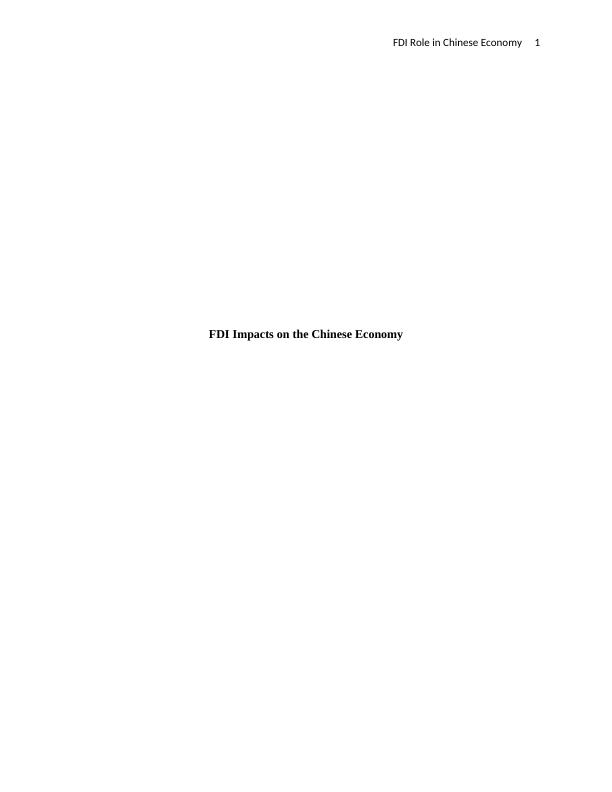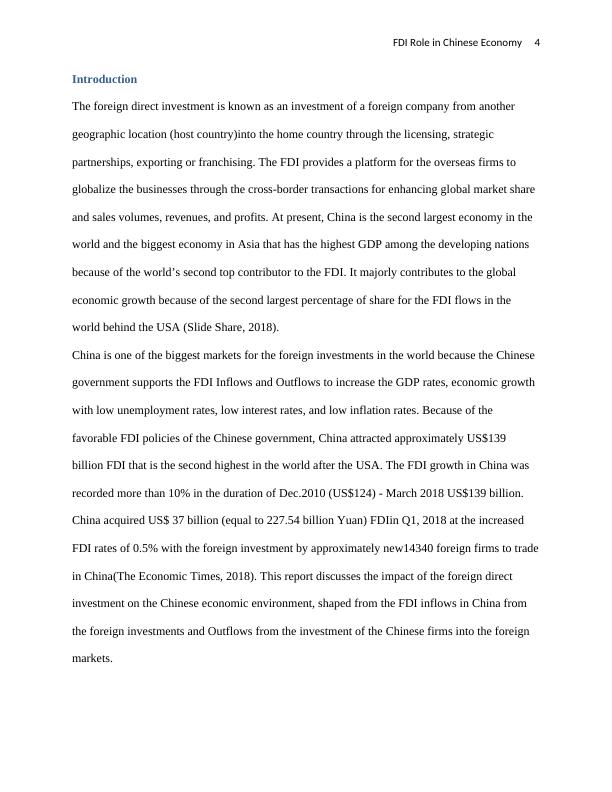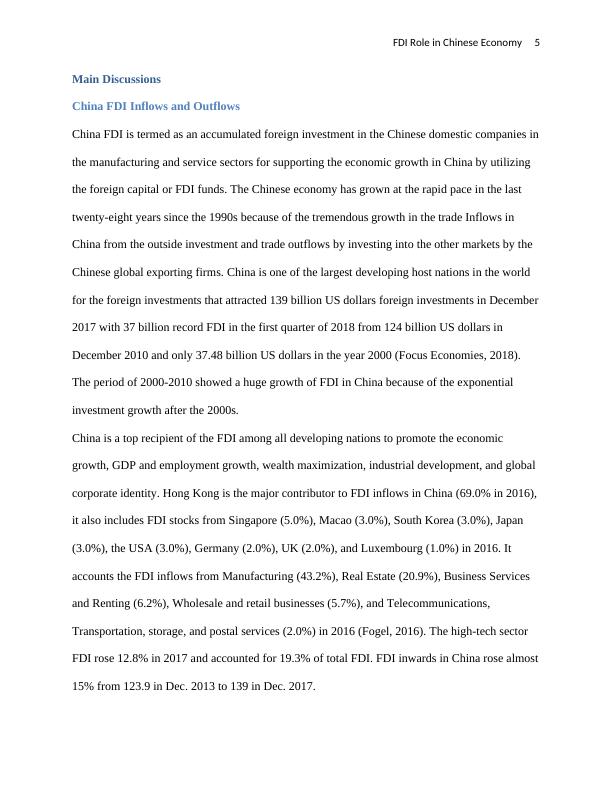FDI Impacts on the Chinese Economy
21 Pages4379 Words430 Views
Added on 2023-06-11
About This Document
This report provides an overview of FDI flows in shaping the Chinese economic environment. It discusses the impact of FDI on the national economic environment, including economic transition, GDP growth, employment growth, and corporate growth. The report also covers China's FDI inflows and outflows, determinant factors and attractions for FDI in China, and the role of FDI in the manufacturing and service sectors.
FDI Impacts on the Chinese Economy
Added on 2023-06-11
ShareRelated Documents
FDI Role in Chinese Economy 1
FDI Impacts on the Chinese Economy
FDI Impacts on the Chinese Economy

FDI Role in Chinese Economy 2
Abstract
The main purpose of the report is to provide a broader outlook of the FDI flows in shaping the
Chinese economic environment. In the last 17 years after the 2000s, the Chinese economy has
recorded huge economic growth due to the increased rates for the FDI flows (inflows and
outflows) to promote the manufacturing growth, employment, and economic transition.
Currently, China is a country for attracting the FDI at the most in the developing nations around
world by using the foreign capitals, foreign investments, and foreign direct investments from the
overseas firms for supporting the Chinese Infrastructural development and modernization
construction. The FDI also contributes to the development of the rural areas, enhancement of the
economic activities, and increase inthe GDP share of China in the world economy. The past three
decades after the 1990s have been meaningful for the significant FDI in China to boost the
national economy to the large extent.
Abstract
The main purpose of the report is to provide a broader outlook of the FDI flows in shaping the
Chinese economic environment. In the last 17 years after the 2000s, the Chinese economy has
recorded huge economic growth due to the increased rates for the FDI flows (inflows and
outflows) to promote the manufacturing growth, employment, and economic transition.
Currently, China is a country for attracting the FDI at the most in the developing nations around
world by using the foreign capitals, foreign investments, and foreign direct investments from the
overseas firms for supporting the Chinese Infrastructural development and modernization
construction. The FDI also contributes to the development of the rural areas, enhancement of the
economic activities, and increase inthe GDP share of China in the world economy. The past three
decades after the 1990s have been meaningful for the significant FDI in China to boost the
national economy to the large extent.

FDI Role in Chinese Economy 3
Contents
Abstract.......................................................................................................................................................2
Introduction.................................................................................................................................................4
Main Discussions........................................................................................................................................5
China FDI Inflows and Outflows.............................................................................................................5
Determinant factors and Attractions for FDI in China.............................................................................6
Impact of FDI in China on the National Economic Environment (Economic Transition, GDP Growth,
Employment growth, and Corporate Growth)..........................................................................................7
Conclusion.................................................................................................................................................12
References.................................................................................................................................................13
Appendix...................................................................................................................................................16
Appendices 1: FDI Inflows China vs. the USA.....................................................................................16
Appendices 2: China’s Inward and Outward FDI Flows.......................................................................16
Appendices 3: China’s Net FDI (1982-2015)........................................................................................17
Appendices 4: China’s Foreign Direct Investment................................................................................17
Appendices 5: FDI Impacts on China GDP and Employment Growth..................................................18
Appendices 6: Impacts of FDI on GDP growth into China....................................................................18
Appendices 7: China GDP’s Realizations and Future Projections.........................................................19
Appendices 8: Total Amount of FDI in Manufacturing and Service Sectors in China 2010-2015........19
Appendices 9: FDI Impacts on Unemployment rates in China..............................................................20
Appendices 10: China: GDP Growth Rates from 2009-2019................................................................21
Contents
Abstract.......................................................................................................................................................2
Introduction.................................................................................................................................................4
Main Discussions........................................................................................................................................5
China FDI Inflows and Outflows.............................................................................................................5
Determinant factors and Attractions for FDI in China.............................................................................6
Impact of FDI in China on the National Economic Environment (Economic Transition, GDP Growth,
Employment growth, and Corporate Growth)..........................................................................................7
Conclusion.................................................................................................................................................12
References.................................................................................................................................................13
Appendix...................................................................................................................................................16
Appendices 1: FDI Inflows China vs. the USA.....................................................................................16
Appendices 2: China’s Inward and Outward FDI Flows.......................................................................16
Appendices 3: China’s Net FDI (1982-2015)........................................................................................17
Appendices 4: China’s Foreign Direct Investment................................................................................17
Appendices 5: FDI Impacts on China GDP and Employment Growth..................................................18
Appendices 6: Impacts of FDI on GDP growth into China....................................................................18
Appendices 7: China GDP’s Realizations and Future Projections.........................................................19
Appendices 8: Total Amount of FDI in Manufacturing and Service Sectors in China 2010-2015........19
Appendices 9: FDI Impacts on Unemployment rates in China..............................................................20
Appendices 10: China: GDP Growth Rates from 2009-2019................................................................21

FDI Role in Chinese Economy 4
Introduction
The foreign direct investment is known as an investment of a foreign company from another
geographic location (host country)into the home country through the licensing, strategic
partnerships, exporting or franchising. The FDI provides a platform for the overseas firms to
globalize the businesses through the cross-border transactions for enhancing global market share
and sales volumes, revenues, and profits. At present, China is the second largest economy in the
world and the biggest economy in Asia that has the highest GDP among the developing nations
because of the world’s second top contributor to the FDI. It majorly contributes to the global
economic growth because of the second largest percentage of share for the FDI flows in the
world behind the USA (Slide Share, 2018).
China is one of the biggest markets for the foreign investments in the world because the Chinese
government supports the FDI Inflows and Outflows to increase the GDP rates, economic growth
with low unemployment rates, low interest rates, and low inflation rates. Because of the
favorable FDI policies of the Chinese government, China attracted approximately US$139
billion FDI that is the second highest in the world after the USA. The FDI growth in China was
recorded more than 10% in the duration of Dec.2010 (US$124) - March 2018 US$139 billion.
China acquired US$ 37 billion (equal to 227.54 billion Yuan) FDIin Q1, 2018 at the increased
FDI rates of 0.5% with the foreign investment by approximately new14340 foreign firms to trade
in China(The Economic Times, 2018). This report discusses the impact of the foreign direct
investment on the Chinese economic environment, shaped from the FDI inflows in China from
the foreign investments and Outflows from the investment of the Chinese firms into the foreign
markets.
Introduction
The foreign direct investment is known as an investment of a foreign company from another
geographic location (host country)into the home country through the licensing, strategic
partnerships, exporting or franchising. The FDI provides a platform for the overseas firms to
globalize the businesses through the cross-border transactions for enhancing global market share
and sales volumes, revenues, and profits. At present, China is the second largest economy in the
world and the biggest economy in Asia that has the highest GDP among the developing nations
because of the world’s second top contributor to the FDI. It majorly contributes to the global
economic growth because of the second largest percentage of share for the FDI flows in the
world behind the USA (Slide Share, 2018).
China is one of the biggest markets for the foreign investments in the world because the Chinese
government supports the FDI Inflows and Outflows to increase the GDP rates, economic growth
with low unemployment rates, low interest rates, and low inflation rates. Because of the
favorable FDI policies of the Chinese government, China attracted approximately US$139
billion FDI that is the second highest in the world after the USA. The FDI growth in China was
recorded more than 10% in the duration of Dec.2010 (US$124) - March 2018 US$139 billion.
China acquired US$ 37 billion (equal to 227.54 billion Yuan) FDIin Q1, 2018 at the increased
FDI rates of 0.5% with the foreign investment by approximately new14340 foreign firms to trade
in China(The Economic Times, 2018). This report discusses the impact of the foreign direct
investment on the Chinese economic environment, shaped from the FDI inflows in China from
the foreign investments and Outflows from the investment of the Chinese firms into the foreign
markets.

FDI Role in Chinese Economy 5
Main Discussions
China FDI Inflows and Outflows
China FDI is termed as an accumulated foreign investment in the Chinese domestic companies in
the manufacturing and service sectors for supporting the economic growth in China by utilizing
the foreign capital or FDI funds. The Chinese economy has grown at the rapid pace in the last
twenty-eight years since the 1990s because of the tremendous growth in the trade Inflows in
China from the outside investment and trade outflows by investing into the other markets by the
Chinese global exporting firms. China is one of the largest developing host nations in the world
for the foreign investments that attracted 139 billion US dollars foreign investments in December
2017 with 37 billion record FDI in the first quarter of 2018 from 124 billion US dollars in
December 2010 and only 37.48 billion US dollars in the year 2000 (Focus Economies, 2018).
The period of 2000-2010 showed a huge growth of FDI in China because of the exponential
investment growth after the 2000s.
China is a top recipient of the FDI among all developing nations to promote the economic
growth, GDP and employment growth, wealth maximization, industrial development, and global
corporate identity. Hong Kong is the major contributor to FDI inflows in China (69.0% in 2016),
it also includes FDI stocks from Singapore (5.0%), Macao (3.0%), South Korea (3.0%), Japan
(3.0%), the USA (3.0%), Germany (2.0%), UK (2.0%), and Luxembourg (1.0%) in 2016. It
accounts the FDI inflows from Manufacturing (43.2%), Real Estate (20.9%), Business Services
and Renting (6.2%), Wholesale and retail businesses (5.7%), and Telecommunications,
Transportation, storage, and postal services (2.0%) in 2016 (Fogel, 2016). The high-tech sector
FDI rose 12.8% in 2017 and accounted for 19.3% of total FDI. FDI inwards in China rose almost
15% from 123.9 in Dec. 2013 to 139 in Dec. 2017.
Main Discussions
China FDI Inflows and Outflows
China FDI is termed as an accumulated foreign investment in the Chinese domestic companies in
the manufacturing and service sectors for supporting the economic growth in China by utilizing
the foreign capital or FDI funds. The Chinese economy has grown at the rapid pace in the last
twenty-eight years since the 1990s because of the tremendous growth in the trade Inflows in
China from the outside investment and trade outflows by investing into the other markets by the
Chinese global exporting firms. China is one of the largest developing host nations in the world
for the foreign investments that attracted 139 billion US dollars foreign investments in December
2017 with 37 billion record FDI in the first quarter of 2018 from 124 billion US dollars in
December 2010 and only 37.48 billion US dollars in the year 2000 (Focus Economies, 2018).
The period of 2000-2010 showed a huge growth of FDI in China because of the exponential
investment growth after the 2000s.
China is a top recipient of the FDI among all developing nations to promote the economic
growth, GDP and employment growth, wealth maximization, industrial development, and global
corporate identity. Hong Kong is the major contributor to FDI inflows in China (69.0% in 2016),
it also includes FDI stocks from Singapore (5.0%), Macao (3.0%), South Korea (3.0%), Japan
(3.0%), the USA (3.0%), Germany (2.0%), UK (2.0%), and Luxembourg (1.0%) in 2016. It
accounts the FDI inflows from Manufacturing (43.2%), Real Estate (20.9%), Business Services
and Renting (6.2%), Wholesale and retail businesses (5.7%), and Telecommunications,
Transportation, storage, and postal services (2.0%) in 2016 (Fogel, 2016). The high-tech sector
FDI rose 12.8% in 2017 and accounted for 19.3% of total FDI. FDI inwards in China rose almost
15% from 123.9 in Dec. 2013 to 139 in Dec. 2017.

FDI Role in Chinese Economy 6
In the first quarter of 2018, China accounted 0.5% growth in the FDI inflows and reaching the
figure of 227.54 billion Yuan (US$ 37 billion) worth. China received almost US$122 billion in
the first 11 months of 2017. Currently, the total FDI (inward and outward) was recorded US$
286.78 in April 2018, decrease from US$ 345.1 in March 2018 and increase from US$120.74 in
January 2018. The FDI was recorded the highest of all times in China in December 2017 with the
net worth of US$ 1310.35 because of the significant amount of investment by the Chinese
Company into the outside markets around the globe(Fetscherin, Voss, and Gugler, 2010).
China’s total Outward flow continually has grown after the 2000s. It was recorded US$145.7
billion in 2015. It is projected to continually rise at the rapid rates because of the increasing
investment by the global Chinese firms into other markets outside of China for the globalization
of their business models.
Determinant factors and Attractions for FDI in China
The FDI in China is determined by the factors, like geographic locations, tax rates, labor market
conditions, unemployment rates, infrastructural support of the government, technological know-
how, and availability of the production technologies and R&D facilities. The Chinese
government majorly attracts the foreign investors for allowing them to trade directly through the
foreign investments into China by the global automakers and other manufacturing industries as
well as retailing supermarkets (Ali and Guo, 2005). The Chinese business environment has many
attractions for the FDI, like the world’s largest population base, improved labor market
conditions with lower laborrates, lower material costs, availability of research facilities,
laboratories, and technical know-how operations are such major attractions for attracting the
foreign investments into the high-growth potential conditions in China with their significant
capital funds. The government support procedure and infrastructural support in China can
In the first quarter of 2018, China accounted 0.5% growth in the FDI inflows and reaching the
figure of 227.54 billion Yuan (US$ 37 billion) worth. China received almost US$122 billion in
the first 11 months of 2017. Currently, the total FDI (inward and outward) was recorded US$
286.78 in April 2018, decrease from US$ 345.1 in March 2018 and increase from US$120.74 in
January 2018. The FDI was recorded the highest of all times in China in December 2017 with the
net worth of US$ 1310.35 because of the significant amount of investment by the Chinese
Company into the outside markets around the globe(Fetscherin, Voss, and Gugler, 2010).
China’s total Outward flow continually has grown after the 2000s. It was recorded US$145.7
billion in 2015. It is projected to continually rise at the rapid rates because of the increasing
investment by the global Chinese firms into other markets outside of China for the globalization
of their business models.
Determinant factors and Attractions for FDI in China
The FDI in China is determined by the factors, like geographic locations, tax rates, labor market
conditions, unemployment rates, infrastructural support of the government, technological know-
how, and availability of the production technologies and R&D facilities. The Chinese
government majorly attracts the foreign investors for allowing them to trade directly through the
foreign investments into China by the global automakers and other manufacturing industries as
well as retailing supermarkets (Ali and Guo, 2005). The Chinese business environment has many
attractions for the FDI, like the world’s largest population base, improved labor market
conditions with lower laborrates, lower material costs, availability of research facilities,
laboratories, and technical know-how operations are such major attractions for attracting the
foreign investments into the high-growth potential conditions in China with their significant
capital funds. The government support procedure and infrastructural support in China can

End of preview
Want to access all the pages? Upload your documents or become a member.
Related Documents
Report on International Business: Doclg...
|18
|3329
|117
Analysis of China's Political Economy for Foreign Direct Investmentlg...
|13
|2254
|302
Total Growth of Singapore Economylg...
|14
|2864
|13
Economics Assignment- Chinese Economylg...
|13
|3562
|109
Comparative Analysis of Macroeconomic Performance of Australia and New Zealandlg...
|20
|3563
|292
Economic and Political Development Case Study 2022lg...
|7
|590
|44
